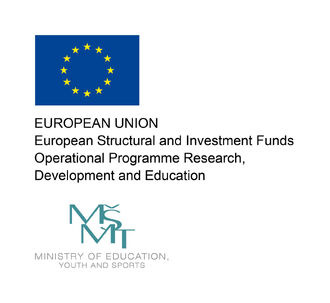IT4Innovations is a research and development centre with strong international links, it is involved in all activities of EuroHPC Joint Undertaking and in a number of prestigious international organisations (PRACE, ETP4HPC, EUDAT, BDVA, EOSC).
IT4Innovations is currently a National Centre of Competence for HPC, a member of the MaX and Space Centres of Excellence and a partner in more than 10 other international projects of Horizon 2020, Horizon Europe or Digital Europe, coordinating the EXA4MIND project. It also collaborates on the European Space Agency (ESA) project called AIOPEN (Platform Extensions with AI Capabilities).
The implementation of national projects financially supported by the Ministry of Education, Youth and Sports, the Ministry of Industry and Trade, the Ministry of the Interior, the Grant Agency of the Czech Republic or the Technology Agency of the Czech Republic is also important. Some of the projects are carried out in the form of contract research with commercial entities.
TOP 5 IT4INnovations PROJEcTs

2023–2026
Project ID: LM2023054
Provider: Large Infrastructures for Research, Experimental Development and Innovation project
e-INFRA CZ is a unique e-infrastructure for research, development, and innovationin the Czech Republic, which represents a fully transparent environment providingcomplex capacities and resources for scientific data transfer, storage, and process-ing to all entities focused on research, development, and innovation across sectors.
It creates a communication, information, storage, and computing platform for re-search, development, and innovation both at the national and international levels. Italso provides an extensive and comprehensive portfolio of ICT services for conduct-ing modern research, development and innovation.
The main components of e-INFRA CZ include:
→ high-performance national communication infrastructure,
→ national grid and cloud infrastructure,
→ most powerful and state-of-the-art supercomputing systems in the Czech Republic,
→ high-capacity data storage facilities.
Other tools and services, such as access control to ICT resources, tools to supportremote cooperation, and tools to ensure secure communication and data protec-tion, are also an essential part and an added value of this infrastructure, contribut-ing to its efficient and diverse use.

EXA4MIND
EXtreme Analytics for MINing Data
2023–2025
Project ID: 101092944
EXA4MIND project will build an Extreme Data platform which brings together data storage systems and powerful computing infrastructures by implementing novel automated data management and effective data staging. The project is driven by four application cases from molecular dynamics, advanced driver assistance systems, smart agri-viticulture and health and social Big Data. The EXA4MIND proposes innovative solutions to complex everyday data-processing problems and addresses critical challenges like data analytics, Machine Learning and Artificial Intelligence at scale; effectively democratising access to and enabling connectivity across EU supercomputing centres.

EuroCC 2
National Competence Centres in the framework of EuroHPC Phase 2
2023–2025
Project ID: 101101903
The mission of EuroCC 2 is to continue the establishment of a network of National Competence Centres (NCC) in the most efficient way while continuing to address the differences in the maturity of HPC deployment in Europe. The main task of the overall activity is to support national centres in setting up their operational frameworks while accessing and making the most of the experience and expertise currently available at national and European levels. The main goal is to drive collaboration, and exchange of best practices and knowledge at the European level and to accelerate the improvement of national and thus European capabilities.

European Open Science Cloud Czech Republic
2023–2028
Project ID: CZ.02.01.01/00/22_004/0007682
The European Open Science Cloud (EOSC) is a European initiative focused on developing infrastructures supporting open science practices in research data management. It offers facilities for storing and sharing so-called FAIR research data – findable, accessible, interoperable, and reusable. The EOSC-CZ project is the implementation of the EOSC initiative in the Czech Republic, which aims to create a national node of this European initiative and promote good practice in research data management across scientific communities. Implementing National Data Infrastructures will create a common platform for sharing, managing, and accessing data and computing resources for research purposes. The NDI will support scientific and multidisciplinary research activities and include various scientific fields and disciplines.
More information here.
MAterials design at the eXascale
2023–2026
Project ID: 101093374
Materials simulations have become one of the most intensive and fast-growing domains for high-performance computing worldwide, with a recognized European leadership in developing and innovating the ecosystem of quantum simulation codes. MAX project will target these lighthouse codes to address the challenges and leverage the opportunities arising from future exascale and post-exascale architectures, and to offer powerful paths to discovery and innovation serving both scientific and industrial applications.
OTHER IT4INNOVATIONS PROJECTS

2025 – 2028
Project ID: CZ.02.01.01/00/23_029/0008437
Grant Provider: Programme Johannes Amos Comenius (MEYS)
The project serves to ensure mandatory national co-financing of the complementary international project of the same name CLARA (Center for Artificial Intelligence and Quantum Computing in System Brain Research). This national part of the project will ensure the acquisition and operation of the computing and data infrastructure of the CLARA project and thus ensure the fulfilment of one of the objectives of the CLARA project - the construction of the Testbed. The CLARA Testbed is based on the creation of an HW and SW platform that provides computational and data facilities for research on neurodegenerative diseases, including the development of new AI models, protein simulations, and connections to quantum computing infrastructure. Specifically, the project will procure an HPCQC – AI computing cluster and corresponding data storage, including funding for the costs of their operation.

2025 – 2028
Project ID: CZ.02.01.01/00/23_021/0008759
Provider: Programme Johannes Amos Comenius (MEYS)
The project focuses on research and development of software tools for analysing installation efficiency and resilience of new energy sources and storage capacities for use within energy communities and research in the field of hydrogen production, transport and storage. This includes social science research to promote acceptance of these specialised technologies by the general public, development of cooperation with the application sector, project preparation, infrastructure upgrade, and compliance with RIS3.

2024 – 2028
Project ID: CZ.02.01.01/00/23_014/0008787
Provider: Programme Johannes Amos Comenius (MEYS)
The project will create a National Repository Platform, a universal facility for efficient work with FAIR research data. The National Repository Platform is a secure system of technical and software resources that will provide sufficient capacity to store and make available the data produced by state-supported projects. On top of this base, a system of services, tools, and methodological procedures will be available for the creation and long-term management of repositories and data care in accordance with FAIR principles.

2023–2026
Project identifier: CZ.02.01.01/00/23_016/0008329
Provider: MEYS CZ, Programme Johannes Amos Comenius
The aim of the project "Modernization of e-INFRA CZ II" is to modernize and upgrade specific components of the e-infrastructure – supercomputers and their facilities, MetaCentre computing clusters and immediately related storage capacities, new large data spaces for active work with data and increasing the capacity, quality and flexibility of the communication infrastructure (computer network CESNET3). This will provide the necessary ICT capacity in a form that will elevate IT infrastructure support to a level that covers the predicted requirements and needs of the user community across a broad spectrum of the research space, while matching the state-of-the-art level of the field.

2023–2028
Project ID: CZ.02.01.01/00/22_004/0007682
Provider: Programme Johannes Amos Comenius
The European Open Science Cloud (EOSC) is a European initiative focused on developing infrastructures supporting open science practices in research data management. It offers facilities for storing and sharing so-called FAIR research data – findable, accessible, interoperable, and reusable. The EOSC-CZ project is the implementation of the EOSC initiative in the Czech Republic, which aims to create a national node of this European initiative and promote good practice in research data management across scientific communities. Implementing National Data Infrastructures will create a common platform for sharing, managing, and accessing data and computing resources for research purposes. The NDI will support scientific and multidisciplinary research activities and include various scientific fields and disciplines.
More information here.

2023–2025
Project ID: LM2023054
e-INFRA CZ is a unique e-infrastructure for research, development, and innovation in the Czech Republic, which represents a fully transparent environment providing complex capacities and resources for scientific data transfer, storage, and processing to all entities focused on research, development, and innovation across sectors. It creates a communication, information, storage, and computing platform for research, development, and innovation both at the national and international levels. It also provides an extensive and comprehensive portfolio of ICT services for conducting modern research, development and innovation.
The main components of e-INFRA CZ include:
→ high-performance national communication infrastructure,
→ national grid and cloud infrastructure,
→ most powerful and state-of-the-art supercomputing systems in the Czech Republic,
→ high-capacity data storage facilities.
Other tools and services, such as access control to ICT resources, tools to support remote cooperation, and tools to ensure secure communication and data protection, are also an essential part and an added value of this infrastructure, contributing to its efficient and diverse use.

2022–2025
Project ID: LUASK22099
Provider: International cooperation in R&D&I
Two-dimensional materials provide a novel building platform for nanotechnology and functional nanodevices. The functional nanodevices, i.e., nano-sized devices, are expected to enter 21st-century modern society. One of them is a non-volatile magnetic memory element controlled by electrical current only involving anomalous effects (e.g., the anomalous Hall effect) due to spin-orbit coupling interaction in materials or on their interfaces. The project builds on the assumption that such an element contains a magnetic part for storing the information and a non-magnetic part with strong spin-orbit coupling, which allows the spin-orbit torque to control the magnetisation dynamics, i.e., reading and writing information. A key question addressed within this project is how the Joule heat produced due to the flow of current in such a nanodevice affects the spin-orbit torque. The project aims at exploring and explaining the proximity and temperature effects on spin-orbit torque in devices made of 2D materials forming van der Waals heterostructures. The experience and computational procedures of both partners (VSB-TUO and Pavol Jozef Šafárik University in Košice) will be applied to determine the thermoe-lectric phenomena and the influence of interfaces for experimentally relevant 2D spin-orbit torque systems.

2021–2023
Project ID: DGS/TEAM/2020-033
Provider: Operational Programme Research, Development, and Education
The proposed project aims to develop computational procedures to solve non- linear structural dynamical problems. Moreover, the procedures will be applied to computational models of rotating machinery, discretised by three-dimensional finite elements, to analyse their vibrations. Within the scope of this project, investigators will develop procedures for (i) steady-state response determination utilising the Harmonic Balance Method (HBM), ii) determination of the amplitude-frequency response curve by the continuation technique, iii) the stability and essential bifurcation analysis of the steady-state response, iv) the identification of an optimal strategy for the amplitude-frequency response curve determination by the application of Total Finite Element Tearing and Interconnecting (T-FETI) on a linearised model, including the application of suitable preconditioners and coarse space projectors, and, v) the determination of the transient response of the model, based on corotational finite element formulation utilising time-integration. The procedures will be created and studied on the test cases in the MATLAB software and subsequently implemented in ESPRESO (ExaScale PaRallel FETI SOlver) developed as an open-source code project at IT4Innovations and tested on real industrial cases.

2021–2022
Project ID: DGS/TEAM/2020-020
Provider: Operational Programme Research, Development, and Education
The project represented a part of a broader research outlook, in collaboration with Université Toulouse III – Paul Sabatier (UPS), focused on investigating low-temperature rare-gas-based plasma for (most importantly) biomedical applications. It covered two double-degree dissertation theses (those of Beseda and Fresnelle) and two other theses (of Horáčková and Paláček). The project focused on modelling plasma interactions with air as the first step towards understanding the interactions between plasma active species with biomedical substrates. This project followed the previous research efforts (one co-supervised thesis, one double-degree thesis, and approximately eleven published papers).

2021–2023
Project ID: DGS/TEAM/2020-008
Provider: Operational Programme Research, Development, and Education
There is an ever-increasing need to visualise data from large computations on HPC systems. Monitoring such systems during their runtime and visualising this information properly is essential. To explore the data more intuitively, it is desirable to use 3D visualisations. For this purpose, we aim to create open-source tools that will allow data to be processed and visualised in high quality and support its presentation in virtual reality (VR). The developed tools will specifically focus on medical data visualisation, HPC cluster runtime monitoring, and the visualisation of simulation results from parallel open-source simulation tools. High-quality visualisations in VR are the primary goal of the project. Another goal is to strengthen cooperation among researchers with different specialisations.
The project will also enable and visualise resource consumption monitoring of IT4Innovations and their visualisation. This feature, which will be greatly appreciated by both administrators and users of these systems, will allow for follow-up research based on the data collected, such as research into energy-aware job scheduling.

2021–2023
Project ID: DGS/TEAM/2020-027
Provider: Operational Programme Research, Development, and Education
The terahertz (THz) spectral range holds immense potential for medical, security, and telecommunications applications. Therefore, it is desirable to develop new sources of terahertz waves with fast response, intense signal, controlled polarisation properties, and easy implementation. In this project, terahertz sources using spintronic phenomena such as terahertz spintronic emitters based on the spin-Hall effect and spin-laser-based THz sources will be designed, developed, and characterised. Photonic and plasmonic structures will be employed to enhance the performance of these devices, including Bragg grating and plasmonic materials for spintronic emitters and anisotropic 2D grating for spin lasers. Nonconventional characterisation methods will be used to describe spin mobility and broadband optical properties, including terahertz plasma-based time-domain spectroscopy and pump-probe terahertz measurements. Numerical simulations of ultrafast dynamics and spin transport will allow a deeper understanding of spin-based generation processes. The project is highly interdisciplinary, including approaches and methods from optics, magnetism, engineering, advanced nanotechnology, high-performance computing modelling, and applied quantum theory.

2020–2023
Project number: CZ.02.1.01/0.0/0.0/18_072/0015659
Provider: Operational Programme Research, Development and Education Project
The project aims to modernise and further develop the capacity of all e-infrastructure components so that the level of IT infrastructure support corresponds to the predicted requirements of the user community for the given period and simultaneously to the state-of-the-art level of the field. The project focuses primarily on the complete upgrade of all layers of the standard communication infrastructure and the upgrade of elements of the universal e-infrastructure capabilities for data storage and processing. An integral part of the solution will then be the optimal technological and logical interconnection of these upgraded capacities with analogous units in the European (GÉANT, EGI, EOSC, EuroHPC, ETP4HPC, EUDAT, PRACE, etc.) and global (GLIF) R&D area and, of course, with related infrastructures and entities at the national level.

Project ID: LM2018140
Provider: Large Infrastructures for Research, Experimental Development and Innovation project
e-INFRA CZ is a unique e-infrastructure for research, development, and innovation in the Czech Republic, which represents a fully transparent environment providing complex capacities and resources for scientific data transfer, storage, and processing to all entities focused on research, development, and innovation across sectors. It creates a communication, information, storage, and computing platform for research, development, and innovation both at the national and international levels. It also provides an extensive and comprehensive portfolio of ICT services for conducting modern research, development and innovation.
The main components of e-INFRA CZ include:
→ high-performance national communication infrastructure,
→ national grid and cloud infrastructure,
→ most powerful and state-of-the-art supercomputing systems in the Czech Republic,
→ high-capacity data storage facilities.
Other tools and services, such as access control to ICT resources, tools to support remote cooperation, and tools to ensure secure communication and data protection, are also an essential part and an added value of this infrastructure, contributing to its efficient and diverse use.

2020–2022
Project ID: 8X20050
Provider: Researcher Mobility Support within international cooperation in R&D&I
The research was a complementary joint work of the following institutions – VSB-TUO, Prešov University, and the Donau-University Krems. The project consisted in finding novel RE-free permanent magnets using a detailed systematic study of Fe-Ta and Fe-Hf compounds using adaptive genetic algorithms. Best predicted structures, i.e., those exhibiting negative enthalpy (an indication of phase stability), high saturation magnetisation, and a uniaxial lattice, were further tested to see if they also show high magnetocrystalline anisotropy, exchange integrals (J’s), and temperature (T_C) of transition from magnetic to paramagnetic state. First, MAE and J’s were obtained from the quantum mechanical calculations using HPC infrastructure, followed by Tc obtained from the atomic spin dynamics calculations. The structural parameters of the most stable candidates were transferred to the Slovak partners to synthesise samples and to measure the number of magnetic quantities like magnetisation, magnetic susceptibility, etc. At the same time, the Austrian partner performed micromagnetic simulations to determine the magnetic behaviour of given materials in terms of their texture, shape, and thickness under various thermal conditions.

Project ID: CZ.02.2.69/0.0/0.0/18_053/0016985
Grant Provider: MEYS CR
The project will facilitate the mobility of 26 researchers of diverse nationalities to and from the Czech Republic. It will thus address the need for more international cooperation in research and the professional growth of human resources in research. Researchers will develop in their fields of study, transferring their knowledge to workplaces and research teams of VSB-TUO. The support is primarily directed at junior researchers with the potential to accelerate their research work.

2019–2022
Project ID: CZ.02.2.69/0.0/0.0/18_058/0010212
Grant Provider: MEYS CR
The project enhanced the quality and profile of educational activities and increased their relevance to the labour market. It implemented new forms of educational methods, established new study programmes, and boosted the internationalisation of the university and ties between the university and its graduates. It implemented methods for increasing the participation of students with special needs and improving the strategy for motivating secondary school students to enrol in tertiary education studies. It enhanced not only the capacities of the management personnel of higher education institutions (HEI) but also the quality of the HEI strategy management. The project’s main objective was to increase the relevance of VSB-TUO educational activities to the needs of the labour market. In practical terms, this means reaching a state where the university’s educational activities reflect the needs and unique features of the MSR labour market and all target groups.

2017–2022
Project ID: CZ.02.2.69/0.0/0.0/16_018/0002713
Provider: Operational Programme Research, Development and Education
The main objective of the project was the establishment of a Doctoral School for Education in Mathematical Methods and Tools in HPC, integrating doctoral studies at Charles University (Faculty of Mathematics and Physics), the Czech Academy of Sciences (Institute of Mathematics), and VSB-TUO and building on their broader research cooperation. Part of the project was the modernisation and internationalisation of one of the doctoral programmes of the Doctoral School (Computational Sciences, VSB-TUO) and the creation of a new double-degree programme in collaboration with Université Toulouse III Paul Sabatier in France. → www.mathinhpc.cz

2017–2022
Project ID: EF16_013/0001791
Provider: Operational Programme Research, Development, and Education
The objective of the project was, among others, to extend IT4Innovations in-house research in the three following fields: 1) Modelling of photonic and spin-photonic structures, design of novel progressive materials based on electronic structure calculations, and bioimage analysis using HPC. In-house research is an essential source of HPC expertise for IT4Innovations, reflected in the infrastructure’s services to its users. 2) Use of approximations involving many-body effects (MB) in electrons. Further, it was the inclusion of temperature effects in computational methods, particularly anharmonic lattice vibration effects, and thus the possibility to study materials in near-realistic conditions. Finally, it was the possibility and access to study phenomena at the mesoscale level, i.e., those including tens of thousands to millions of atoms, such as the effect of interfaces, dislocations, and other defects on material properties, as they exist in natural materials and often limit their use. 3) Creating a globally unique platform for analysing biological and biomedical image data using the open-source FIJI platform’s high-performance computing (HPC) infrastructure.

2017–2022
Project ID: CZ.02. 1. 01/0. 0/0.0/15_003/0000466
Provider: Operational Programme Research, Development, and Education
The project yielded significant measures for developing informatics, robotics, and cybernetics research at the Czech Technical University in Prague. The project established a new AI and Reasoning research group within a given part of the Czech Institute of Informatics, Robotics, and Cybernetics (CIIRC), which focused on solving advanced interdisciplinary problems of high technical and social priority. The project was also supported by national partners (VSB-TUO and the University of West Bohemia in Pilsen). The motivation for their participation stems from the emphasis not only on the concentration and integration of resources and sharing of knowledge and infrastructure but also on establishing a “unified space for opportunities” for young talents in the Czech Republic.

